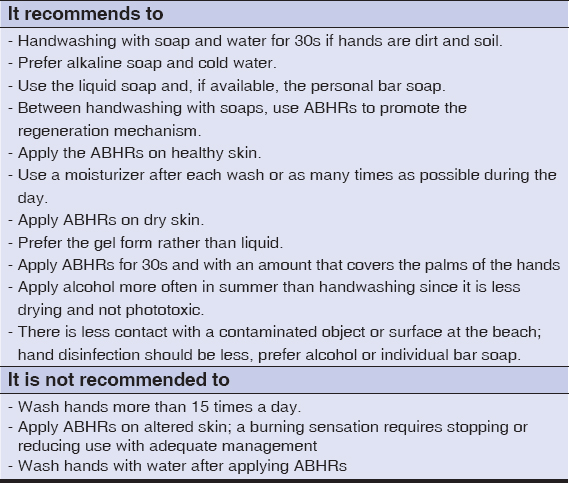Summer in time of Coronavirus disease 2019: How to use hand sanitizers?
Farah Marraha , Ibtissam Al Faker, Najlaa Rahmani, Younes Benyamna, Salim Gallouj
, Ibtissam Al Faker, Najlaa Rahmani, Younes Benyamna, Salim Gallouj
Department of Dermatology, University Hospital Center of Tangier, Tetouan, Al Hoceima, Faculty of Medicine and Pharmacy Tangier, Abdelmalek Essaadi University, Tangier, Morocco
Corresponding authors: Dr. Farah Marraha, Dr Ibtissam Al Faker
Submission: 06.08.2020; Acceptance: 29.08.2020
DOI: 10.7241/ourd.2020S.11
Cite this article: Marraha F, Al Faker I, Rahmani N, Benyamna Y, Gallouj S,. Summer in time of Coronavirus disease 2019: How to use hand sanitizers? Our Dermatol Online. 2020;11(Supp. 2):29-30.
Citation tools:
Copyright information
© Our Dermatology Online 2020. No commercial re-use. See rights and permissions. Published by Our Dermatology Online.
Sir,
Since Pandemic COVID-19 began, disinfecting and hands washing with soap or alcohol-based hand rubs (ABHRs) have been among the most economical, easiest, and essential measures to prevent the virus spread. Both methods, hand washing or the use of ABHRS, have proven their effectiveness on SARS-CoV-2 ( severe acute respiratory syndrome coronavirus 2). After 4 months of using these products, several side effects have been reported, especially for health workers. In this article, we will try to deduce some recommendations for hand hygiene (Table 1), useful especially as summer begins.
 |
Table 1: Recommendations |
SOAP
Over the years, handwashing with soap and water has been considered a measure of personal hygiene; and now, it became a ritual to avoid contamination during the COVID-19 pandemic.
Soap works by dissolving the lipid membranes of microbes, then making them inactive. It has been demonstrated that water containing 1.00% powdered is useful in removing viruses and deactivates their envelope, including coronavirus .
The soap must be obtained from a liquid dispenser; the bar form is not recommended since it may contain germs. However, other studies have shown that the risk of transmitting microorganisms by washing hands with previously used bar soap is negligible (1).
ALCOHOL-BASED HAND RINSES (ABHRS)
According to WHO, the (ABHR) preparation must contain (2):
- Alcohol (Ethanol, propanol): active component in the formulation which has an antimicrobial activity capable of denaturing and coagulating proteins.
- An antibacterial agent (hydrogen peroxide (H2O2), in low concentration, used only for the inactivation of bacterial spores potentially present in the bulk product and the recipients.
- Glycerol or other emollients that help prevent drying of the skin.
- Distilled or boiled and cooled water.
- The addition of other ingredients or perfumes is not recommended.
A recent study has confirmed the effectiveness of these WHO-recommended formulations on Sars-CoV-2 (3).
Three formats of the ABHR are recognized (gel, liquid, or foam); some studies have tried to compare their effectiveness and their virucidal action. It has been suggested that, for the adequate dose, the liquid form is much more acceptable since it is faster to dry and gives a less sticky feeling. The gel seemed to be more moisturizing. The foam format combined the two proprieties (4).
There is no precise volume of application; it varies between 1.5 and 3ml, which is equivalent to one pump from the foam bottle. Nevertheless, the quantity that is recommended by The World Health Organization is one that can cover all surfaces of the hand (2).
Summer season begins, and some dermatologists reported that the sun exposure after the application of(ABHRs) could cause burns or irritation. Still, the components of (ABHRs) are not photo-sensitizing; a study (5) realized to compare the local tolerance of alcohols commonly used an alcohol-based hand rubs for hand hygiene (ethanol, propanol) have confirmed this fact.
Hand washing after ABHRs application is not recommended, water is capable of removing superficial sebum layer as well as eliminating the emollients associated with ABHRs for hydration.
Consent
The examination of the patient was conducted according to the principles of the Declaration of Helsinki.
REFERENCES
1. Bannan EA, Judge LF. Bacteriological Studies relating to handwashing. Am J Public Health Nations Health. juin 1965;55:915-22.
2. Boyce JM, Pittet D, Healthcare Infection Control Practices Advisory Committee. Society for Healthcare Epidemiology of America. Association for Professionals in Infection Control. Infectious Diseases Society of America. Hand Hygiene Task Force. Guideline for Hand Hygiene in Health-Care Settings:recommendations of the Healthcare Infection Control Practices Advisory Committee and the HICPAC/SHEA/APIC/IDSA Hand Hygiene Task Force. Infect Control Hosp Epidemiol. déc 2002;23(12 Suppl):S3-40.
3. Kratzel A, Todt D, V’kovski P, Steiner S, Gultom M, Thao TTN, et al. Inactivation of severe acute respiratory syndrome Coronavirus 2 by WHO-recommended hand rub formulations and alcohols. Emerg Infect Dis. 2020;26:1592-5.
4. Greenaway RE, Ormandy K, Fellows C, Hollowood T. Impact of hand sanitizer format (gel/foam/liquid) and dose amount on its sensory properties and acceptability for improving hand hygiene compliance. J Hosp Infect. 2018;100:195-201.
5. Manche M, FolignéB, Sauty M, Platel A, Vercauteren E, Rauwel G, et al. Comparative assessment of local tolerance of alcohols commonly used in alcohol-based hand rubs for hand hygiene. Toxicol Vitro. 2017;44:142-53.
Notes
Source of Support: Nil,
Conflict of Interest: None declared.
Request permissions
If you wish to reuse any or all of this article please use the e-mail (brzezoo77@yahoo.com) to contact with publisher.
| Related Articles | Search Authors in |
|
 http://orcid.org/0000-0002-4465-954X http://orcid.org/0000-0002-4465-954X http://orcid.org/0000-0001-8134-2579 http://orcid.org/0000-0001-8134-2579 |



Comments are closed.